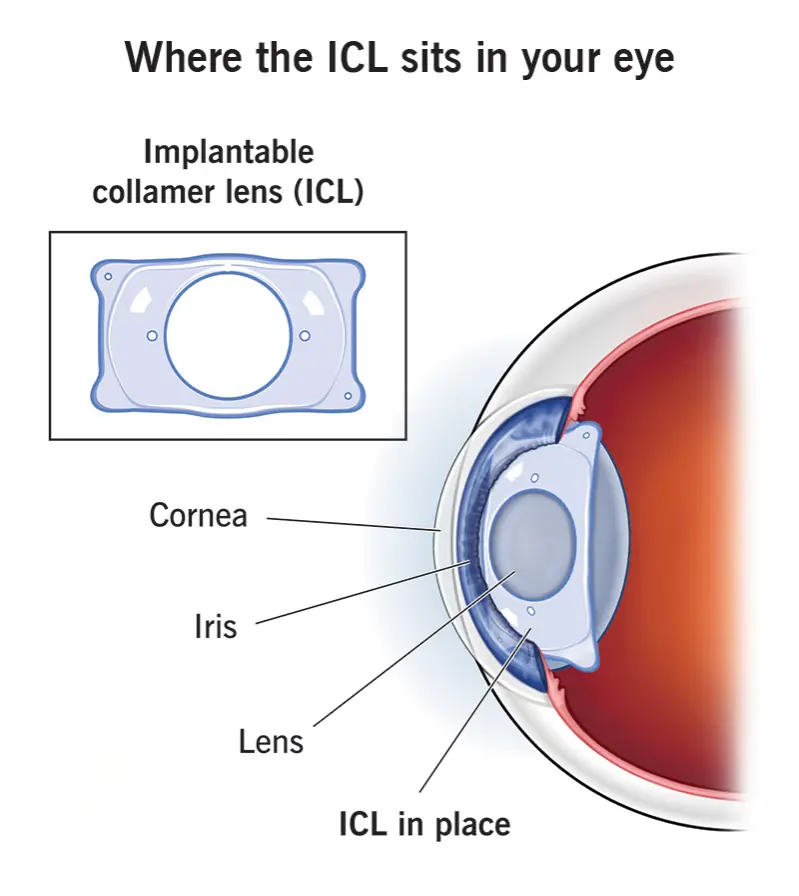What Is ICL Surgery?
Implantable Collamer Lens (ICL) eye surgery is a procedure that corrects refractive errors like astigmatism, myopia, hypermetropia, and more. Unlike LASIK or PRK, which reshape the cornea, ICL surgery involves inserting a thin, flexible lens between the eye’s natural lens and the iris. This placement helps improve visual acuity without altering the corneal structure.
The material used in ICL lenses, Collamer, is biocompatible. This means that the human body accepts it quickly and like its own. This reduces the risk of complications compared to other corrective eye surgeries. ICL operation for eyes is especially beneficial for unsuitable candidates for LASIK.

What Conditions Can Be Treated with ICL Procedure?
- Nearsightedness (Myopia): ICL surgery is ideal for individuals who struggle to see objects at a distance due to myopia.
- Farsightedness (Hyperopia): ICL surgery can help correct this refractive error for those with difficulty seeing objects up close.
- Astigmatism: Implantable Collamer Lens can correct moderate to high levels of astigmatism. This condition causes blurry vision due to an irregularly shaped cornea or lens.
- Thin Corneas: Individuals who cannot undergo LASIK due to thin corneas are often suitable candidates for ICL surgery.
Benefits of ICL Surgery
- High Visual Clarity: Implantable Collamer Lens provides sharp, clear vision for individuals with high eye power or complex refractive errors.
- Reversible Procedure: The ICL can be removed or replaced, offering flexibility if vision needs change
- No Corneal Reshaping: Unlike LASIK, ICL surgery does not involve removing or reshaping any part of the cornea, preserving the natural structure of the eye.
- Biocompatibility: The collamer lens is made from natural materials readily accepted by the human body and not treated as an alien object.
- UV Protection: ICL lenses provide additional protection from harmful UV rays, preserving overall eye health.
Eligibility Criteria for ICL Surgery
- Individuals with High Prescriptions: Patients with severe myopia or astigmatism that cannot be corrected with LASIK are excellent candidates for ICL surgery.
- People with Thin Corneas: Those not eligible for LASIK due to thin or irregular corneas can rely on ICL as a safe alternative.
- Patients Aged 21 to 45: ICL surgery is typically recommended for people within this age range because their prescriptions tend to stabilise.
- People Seeking Reversible Vision Correction: Since the ICL can be removed, this surgery is a great option for individuals looking for a flexible vision correction solution.
- Individuals Without a History of Eye Diseases: Candidates should not have any significant history of eye diseases like glaucoma or cataracts to undergo ICL surgery safely.
ICL Eye Surgery Procedure
Pre-surgery Preparation
Before ICL surgery, a thorough eye examination is conducted to assess your eye health, power, and eligibility. Your surgeon may also recommend not using contact lenses for a few weeks before the surgery. This is because contact lenses alter the shape of your cornea temporarily. Measurements of your eye, including the length and thickness, are taken to ensure the correct lens size. You’ll also be informed about the ICL surgery cost at this stage.
During the Surgery
ICL surgery is quick and painless, usually within 20 to 30 minutes. A numbing eye drop is applied to prevent discomfort, and a small incision is made in the cornea. The Implantable Collamer Lens is then folded and inserted into the space between your iris and the natural lens through the incision. Once in place, the lens unfolds and is adjusted for optimal vision correction. The incision heals naturally without stitches, resulting in quicker recovery.
After Surgery
Post-surgery, you may experience slight blurriness or sensitivity to light, which is normal and temporary. Your eye surgeon will provide eye drops to help with healing and prevent infection. A follow-up appointment is typically scheduled the day after surgery to monitor any side effects of ICL surgery. Most patients experience improved vision within a day or two, although full recovery may take a few weeks.
What is the Recovery Time of ICL Surgery?
The recovery time for ICL surgery is generally quick, with most patients returning to their normal activities within two to three days. While you may experience some light sensitivity or blurriness immediately after the surgery, these side effects typically subside within the first week. It’s important to avoid rubbing your eyes and follow your surgeon’s post-operative care instructions to ensure no complications from ICL treatment for eyes.
Precautions of ICL (Implantable Collamer Lens) Surgery
- Avoid Rubbing of Eyes: After surgery, it’s crucial not to rub your eyes to prevent any ICL complications.
- Follow-Up Visits: Attending all follow-up appointments ensures your eyes are healing properly and helps your surgeon detect any early signs of complications.
- Take Medicines as Prescribed: Use prescribed eye drops to reduce inflammation and prevent infections.
- Avoid Strenuous Activities: For the first few weeks after surgery, avoid heavy lifting, swimming, or any activities that may put stress on your eyes.
- Use Sunglasses: Protect your eyes from UV rays by wearing sunglasses, especially in bright sunlight.
Possible ICL Surgery Complications
- Infection:As with any surgical procedure, there is a small risk of infection, but this can be minimized by following post-operative care instructions and using prescribed eye drops.
- Increased Eye Pressure: Some patients may experience elevated intraocular pressure after surgery, which can usually be managed with medication or additional treatment.
- Cataract Development: Although rare, there is a slight risk of developing cataracts due to the positioning of the Implantable Collamer Lens, especially if patients have other underlying health issues.
- Night Glare or Halos: Some individuals report seeing halos or glare around lights, particularly at night, after the surgery.
- Lens Dislocation: While uncommon, the implanted lens can shift from its original position, requiring a follow-up procedure for adjustment.

